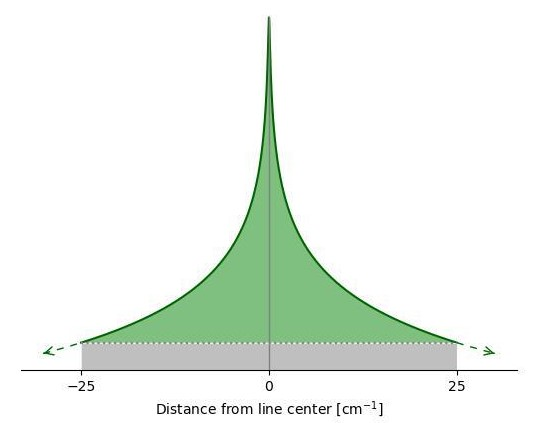Introduction
The current version of the MT_CKD Water Vapor Continuum Model is available from the following GitHub link:
The MT_CKD (Mlawer-Tobin-Clough-Kneizys-Davies) Water Vapor Continuum Model [1, 2, 3] provides absorption coefficients due to water vapor that should be added to the local contributions (see Figure 1 for definition) of water vapor transitions, such as are available in the HITRAN line-by-line section, to obtain the total absorption due to water vapor. When compared to the line absorption, the continuum absorption coefficients have relatively slow spectral variation.
Users are referred to the GitHub overview and the following user guide for more detailed information on the MT_CKD Water Vapor Continuum Model:
The MT_CKD Water Vapor Continuum provides absorption coefficients for the water vapor self continuum (due to interactions of a water molecule with other water molecules) and the water vapor foreign continuum (due to interactions of a water vapor molecule with molecules in air other than H2O). A netCDF file distributed with the model contains continuum coefficients (at a reference density corresponding to P = 1013 mbar and T = 296 K) for both the self continuum and foreign continuum. This file also contains self continuum temperature-dependence coefficients that enable the self continuum coefficients to be modified from their reference temperature (296 K). The code that accompanies this data file performs the appropriate scaling and interpolation that allows continuum absorption coefficients to be computed at arbitrary pressures, temperatures, and wavenumbers.
The MT_CKD Water Vapor Continuum Model is constrained so that it is consistent with quality analyses of spectral atmospheric and laboratory measurements. Keeping the MT_CKD continuum consistent with current observational studies necessitates periodic updates to the water vapor continuum coefficients. A list of revisions to the MT_CKD Water Vapor Continuum Model can be found on the model's "What's New" page.
Water vapor continuum coefficients in spectral regions that have not been subject to compelling analyses are determined by a mathematical formulation of the spectral shape associated with each water vapor monomer line. This formulation is applied consistently to all water vapor lines from the microwave to the visible, and the results are summed (separately for the self and foreign) to obtain continuum coefficients from 0-20,000 cm-1. This formulation has been derived based on the continuum in spectral regions in which the coefficients are known with low uncertainties.

Figure 1: The local line shape contribution for a water vapor line is given by the difference between the green curve (the Lorentz line shape, shown here on a log scale) and the dotted gray line (the Lorentz "pedestal"). The pedestal is defined as the Lorentz line shape value at ±25 cm-1 from the line center and is included the MT_CKD Water Vapor Continuum Model.
Note
Users should note that in the MT_CKD full continuum model, the component of the absorption by N2 due to interactions with H2O is treated as part of the nitrogen continuum (i.e., not as part of the MT_CKD Water Vapor Continuum Model). This component can be obtained from the MT_CKD full continuum model. However, note that HITRAN provides the N2-H2O theoretical collision-induced absorption in the region of N2 fundamental (1930-2830 cm-1). Therefore users should exercise caution so as not to double-count these sources of absorption when using the MT_CKD Water Vapor Continuum Model.
Citation
If you use the MT_CKD Water Vapor Continuum Model in your research, please indicate the version and cite using the following reference:
- E.J. Mlawer, K.E. Cady-Pereira, J. Mascio, I.E. Gordon, The inclusion of the MT_CKD water vapor continuum model in the HITRAN molecular spectroscopic database, J. Quant. Spectrosc. Radiat. Transfer 306, 108645 (2023) [Link to article] .
License
Copyright ©, Atmospheric and Environmental Research, Inc., 2022.
Enquiries
Users with questions specific to the MT_CKD Water Vapor Continuum Model are advised to contact aer_contnm@aer.com.
References
[1] E.J. Mlawer, V.H. Payne, J.-L. Moncet, J.S. Delamere, M.J. Alvarado, D.D. Tobin, Development and recent evaluation of the MT_CKD model of continuum absorption, Phil. Trans. Roy. Soc. A 370, 1-37 (2012) [Link to article] .
[2] E.J. Mlawer, D.D. Turner, S.N. Paine, L. Palchetti, B. Bianchini, V.H. Payne, et al., Analysis of Water Vapor Absorption in the Far-Infrared and Submillimeter Regions Using Surface Radiometric Measurements From Extremely Dry Locations, J. Geophys. Res. Atmos. 124, 8134-8160 (2019) [Link to article] .
[3] E.J. Mlawer, K.E. Cady-Pereira, J. Mascio, I.E. Gordon, The inclusion of the MT_CKD water vapor continuum model in the HITRAN molecular spectroscopic database, J. Quant. Spectrosc. Radiat. Transfer 306, 108645 (2023) [Link to article] .
Users are also referred to the list of references and publications available alongside the documentation for the MT_CKD Water Vapor Continuum Model.